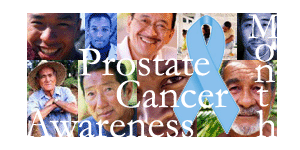|
|
 |
Highlights in Minority Health
September, 2003

|
SEPTEMBER IS PROSTATE CANCER AWARENESS MONTH |
| |
Prostate cancer is the most common cancer in North
American men (other than skin cancer). It is the second leading
cause of cancer death in men (after lung cancer). |
| |
About 16 percent of American men will be diagnosed
with prostate cancer during their lifetime; 8 percent will develop
significant symptoms; and 3 percent will die of the disease. |
| |
Blacks in the U.S. have the highest rates of this
cancer in the world. Although the incidence among whites is quite
high, it is distinctly lower than among blacks. Asian and American
Indian
men have the lowest rates. |
| |
 |
Click
here to view a slide
showing the Age-Adjusted Prostate Cancer Incidence & Mortality Rates
per 100,000 Males by Race/Ethnicity: United States, 1998. |
|
SCREENING |
| |
The main
screening tools for prostate cancer are the digital rectal
exam (DRE) and the prostate-specific antigen (PSA) test. |
| |
Screening for prostate cancer is controversial, because it is not yet
known if the process actually saves lives, and it is not always clear
that benefits outweigh the risks of diagnostic tests
and treatments. The reason: many prostate
cancers found through screening are slow-growing and might never cause
symptoms. |
| |
For most men there is no "right" answer. It is important for you to
make your own decision, taking into consideration the advice of your
doctor and the best, most up-to date information you can gather. |
| |
Prostate Cancer Screening: A Decision Guide is designed to help a
man decide whether screening is right for him. The 17-page guide
discusses the prostate, prostate cancer, and the screening tests in an
easy-to-read question and answer format. |
| |
Screening for Prostate Cancer: Sharing the Decision Slide Set is
designed to help primary care providers understand
the uncertainty surrounding the evidence on the effectiveness of
prostate cancer screening and the benefits and harms of screening, and
to encourage use of shared decision-making and provide information
about how to do it. |
|
WHAT
YOU CAN DO |
| |
Since prostate cancer is less common in populations with low-fat,
high-fiber diets, scientists are looking into the possibility
of using diet to prevent prostate cancer from developing.
There is still no evidence to show that switching to a healthy diet
after years of eating high-fat foods will make a difference, but
small studies are testing the effects of a low fat, high-soy diet
among men who have an increased risk of prostate cancer and men who
have already been treated for prostate cancer. |
| |
Some Questions To Ask Your Doctor |
|
|
What is causing my prostate
symptoms? Are they a sign of cancer? |
|
|
What tests do you recommend? Why? |
|
|
If I don't have cancer, what can I
do about my symptoms? What if they get worse? |
|
|
If I do have prostate cancer,
where can I get information about my treatment options? |
|
|

![]()
![]()
